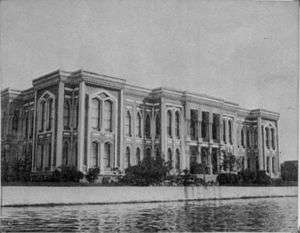House of Camondo
The Camondo family was a prominent European family of Jewish financiers and philanthropists.
Part of the Sephardic community in Spain, the Camondo family settled in Venice after the 1492 Spanish decree that ordered the expulsion of all Jews who refused conversion to Catholicism. There, some of its members became famous for their scholarship and for the services which they rendered to their adopted country. Following the Austrian takeover of Venice in 1798, members of the Camondo family established themselves in Istanbul. Despite the many restrictions and sumptuary laws imposed on all minorities, the family flourished as merchants in the business section at Galata at the outskirts of the city. They branched into finance in 1802 with the founding of their own bank, Isaac Camondo & Cie. On Isaac's death in 1832 his brother Abraham Salomon Camondo inherited the bank. He prospered greatly and became the prime banker to the Ottoman Empire until the founding of the Imperial Ottoman Bank in 1863. In 1866, the year Venice became part of Italy after a peace treaty ended the Austro-Prussian War, Abraham Salomon Camondo's son Raphaël died. In 1869, the eighty-six-year-old patriarch followed his grandsons Behor Abraham Camondo and Nissim de Camondo to Paris, France, a city the family had previously frequented and where they had established business connections. In recognition of his contributions and financial assistance to the liberation of Venetia from the Austrian Empire, in 1870 Abraham Salomon Camondo was created a hereditary count by King Victor Emmanuel II of Italy. Abraham died three years later in Paris but in accordance with his wishes his remains were returned to Istanbul for burial there in the Jewish cemetery at Hasköy, a neighbourhood on the Golden Horn in Istanbul. His two grandsons remained in Paris and continued to successfully expand their banking business.
This family is now extinct; the last descendants, Nissim de Camondo was killed in aerial combat during World War I in 1917, his father Moïse de Camondo died in 1935, his daughter (and sister of Nissim) Béatrice de Camondo, and her two children Fanny and Bertrand as well as her husband Léon Reinach were deported and murdered in Auschwitz from 1943 to 1945 during World War II.
Principal members of the Camondo family
Principal members of the Camondo family include:
- Abraham Salomon Camondo (1781–1873), Jewish-Turkish banker and philanthropist
- Salomon Raphaël Camondo (1810–1866)
- Behor Abraham Camondo (1829–1889)
- Isaac de Camondo (1851–1911)
- Nissim Camondo (1830–1889)
- Moïse de Camondo (1860–1935), French banker and art collector
- Nissim de Camondo (1892–1917), French banker and World War I pilot
- Béatrice de Camondo (1894–1944), French socialite
- Moïse de Camondo (1860–1935), French banker and art collector
- Behor Abraham Camondo (1829–1889)
- Salomon Raphaël Camondo (1810–1866)
Notable buildings constructed by the Camondo family
Istanbul
Camondo Palace

The seaside mansion of the Camondo family, popularly known as the Camondo Palace (Kamondo Sarayı),[1] was built between 1865 and 1869 and designed by architect Sarkis Balyan.[2][3] It is located on the northern shore of the Golden Horn, within the Kasımpaşa quarter of the Beyoğlu district, to the west of Galata (Karaköy). It later became the headquarters of the Ministry of the Navy (Bahriye Nezareti)[2][3] during the late Ottoman period, and is currently used by the Turkish Navy as the headquarters of the Northern Sea Area Command (Kuzey Deniz Saha Komutanlığı).)[1][2][3]
Camondo Apartment Buildings
The Camondo family also built two historic apartment buildings in Galata, both of which are named Kamondo Apartmanı: the older one is located at Serdar-ı Ekrem Street near Galata Tower and was built between 1861 and 1868;[1] while the newer one is located at the corner between Felek Street and Hacı Ali Street and was built in 1881.[4]
Camondo Steps
The Camondo Steps, a famous pedestrian stairway designed with a unique mix of the Neo-Baroque and early Art Nouveau styles, was built in circa 1870–1880 by Abraham Salomon Camondo. It is located on Bankalar Caddesi (Banks Street) in the Galata (Karaköy) quarter of Istanbul.[5]
See also
References
- 1 2 3 Kamondo Apartmanı (1868) at Serdar-ı Ekrem Street
- 1 2 3 Bahriye Nezareti (Ministry of the Navy) building
- 1 2 3 Bahriye Nezareti (Ministry of the Navy) building
- ↑ National inventory of historic buildings: Kamondo Apartmanı (1881) between Felek Street and Hacı Ali Street
- ↑ Camondo Steps on the Bankalar Caddesi
Further reading
- Assouline, Pierre (1999). Le Dernier des camondo. Gallimard. ISBN 2-07-041051-X. (French)
- Malino, Frances; Sorkin, David (1991). "Abraham de Camondo of Istanbul: The Transformation of Jewish Philanthropy". From East and West: Jews in a Changing Europe 1750–1870. Blackwell. pp. 46–56. ISBN 0-631-16602-5.
- Seni, Nora (1994). "The Camondos and Their Imprint on 19th-Century Istanbul". International Journal of Middle East Studies. 26 (4): 663–675. doi:10.1017/S002074380006116X.
- Seni, Nora (1997). Les Camondo, ou, L'éclipse d'une fortune (Hébraïca). Actes Sud. ISBN 2-7427-1421-9. (French)
External links
- Camondo family tree (French)